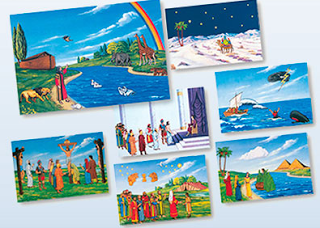Here are some specific suggestions to help you tell a Bible story using flannelgraph.
1. Be prepared. If you are not prepared, this will not be successful. You may need to practice a couple times before tellling the story to children.
2. Before Bible time, collect the flannel board, scenes, characters, and props needs.
3. In a stack, lay the characters and figures in order so that you can easily pick up what is needed next as you tell the story.
4. Before beginning, place the background scenes on the flannel board.
5. Use the figures and props to aid in telling the story, not take over the plot.
Here is an example given in the Teacher’s Manual:
Wrong: “Now, this is Noah. See his long beard and his very beautiful robe!…”
Correct: [As figure of Noah is placed on the board] “Noah did just as God told him to do. Every day he preached to the people [as figures of people are added] …
6. With younger children less is sometimes more. The short attention span of young children be not be able to handle all of the details. You may be able to add an extra figure each time/day you tell the story.
Here is an example: On Monday show Jesus and the little lost lamb. On Tues. have Jesus, the lamb, and add the 99 he left behind to hunt for the one, etc.
7. Don’t stand in front of the flannel board.
8. Placement of characters is very important. Make sure that people are “grounded” (not floating in the air) and children don’t appear to be taller than adults.
9. My Grandma never told a Bible story to children without the Bible in her lap. I would suggest having the Bible open and if you need the manual, lay it on top of the Bible. It is important for little ones to realize you aren’t just telling them a story but it is from God’s word.
10. Relax and have fun. Children are very forgiving!
Some suggestions taken from the Teacher’s Manual. Thank you Aunt C for other great ideas.

